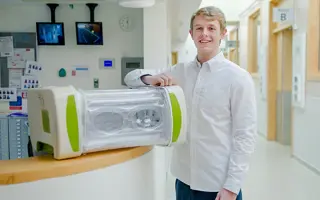News
MOM wins 2014 James Dyson Award
2014 James Dyson Award winner solves the problem of death caused by premature birth in the developing world with a low cost, inflatable incubator.

More than one in ten babies worldwide are born prematurely. According to the World Health Organization, 75% of deaths resulting from premature birth could be avoided if inexpensive treatments were more readily available across the globe. 2014 James Dyson Award winner solves this problem with a low cost, inflatable incubator for use in the developing world.
The device can be collapsed for transportation and runs off a battery which lasts 24 hours, in case of power outages. The incubator is blown up manually and it is heated using ceramic heating elements. A screen shows the current temperature and the humidity which can be custom set, depending on the gestation age. An alarm will sound if the desired temperature changes. And for babies that suffer from Jaundice there is a phototherapy unit.
The design engineer behind MOM is James Roberts, 23, a graduate from Loughborough University in England. Winning the James Dyson Award will provide his team with £30,000 for further prototyping and testing with a view to ultimately seeing MOM mass produced. Loughborough University will also receive £10,000.James Dyson said:
“James’ invention shows the impact design engineering can have on people’s lives. The western world takes incubators for granted – we don’t think about how their inefficient design makes them unusable in developing countries and disaster zones. By bravely challenging convention, James has created something that could save thousands of lives.”Providing the same performance as a $40,000 modern incubation system, MOM costs a fraction of the price to manufacture, test and transport to the desired location.
James Roberts said:“I was inspired to tackle this problem after watching a documentary on for the high death rate among premature babies in refugee camps. It motivated me to use my design engineering skills to make a difference. Like many young inventors, there have been struggles along the way – I had to sell my car to fund my first prototype! The dream would be to meet a child that my incubator has saved – living proof that my design has made a difference.”
